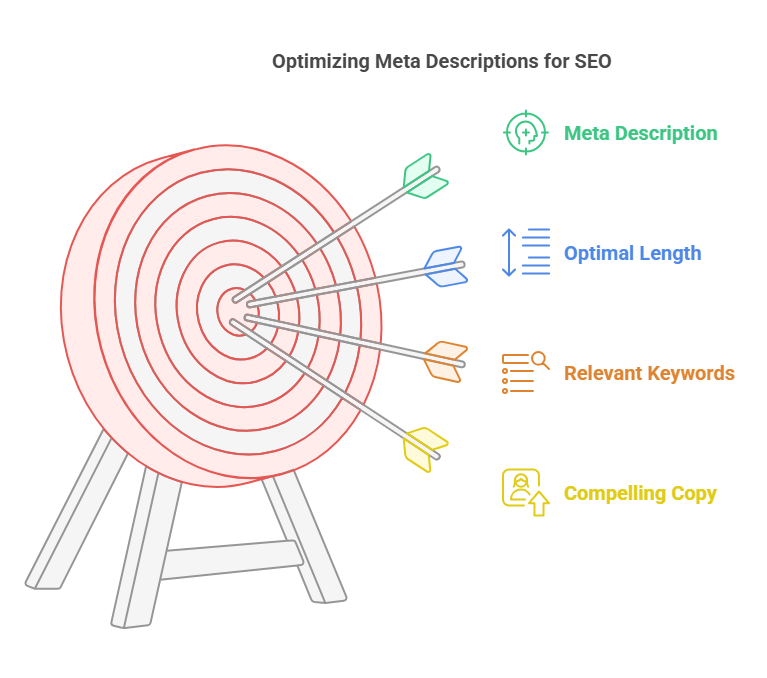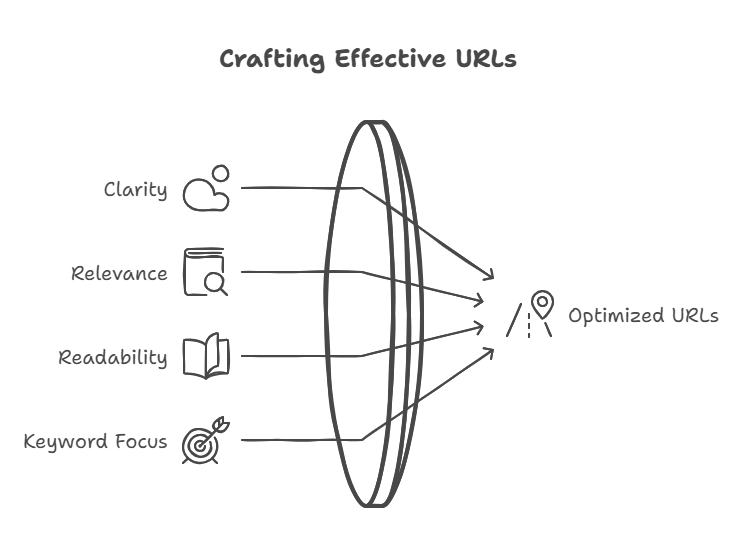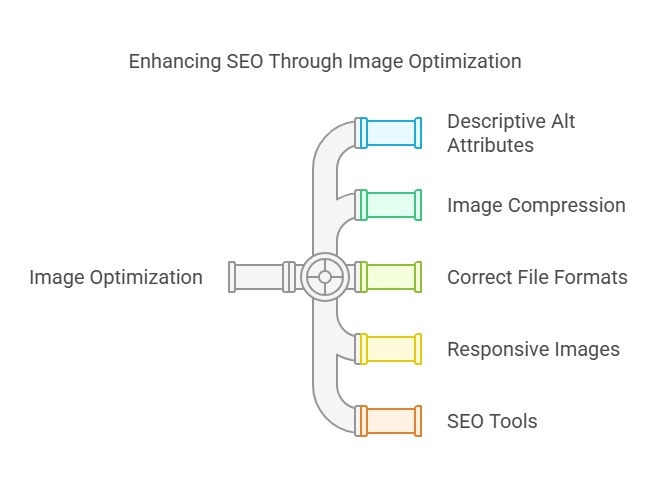To keep my SEO simple, and of course to boost website visibility… and attract more organic traffic, I focus on these 10 essential on-page SEO best practices: craft unique, keyword-rich title tags and meta descriptions; structure URLs clearly; use header tags hierarchically; optimize content with relevant keywords; compress and alt-tag images; develop an internal linking strategy; link to authoritative external sources; configure outbound links to open in new windows; and improve page speed and mobile-friendliness. Focus on these core elements, and you’ll enhance your site’s search engine rankings and user experience. Keep exploring to uncover the secrets behind each best practice and take your SEO game to the next level.
On This Page
Title Tag
Always include a unique, concise, and keyword-rich title tag on every page of your website.
Title tag importance can’t be overstated; it’s a vital on-page SEO element that search engines use to understand your page’s content and determine its relevance to search queries.
Keep your title tags within the recommended title tag length of 50-60 characters to guarantee they display properly in search results.
Incorporate your primary keyword near the beginning of the title tag, but don’t sacrifice readability for keyword stuffing.
Craft compelling, click-worthy titles that accurately reflect your page’s content and entice users to click through from the search results.
Meta Description
In my experience, keeping meta descriptions between 120-160 characters gives them the best chance to display fully in search results. I’ve found that crafting concise, compelling descriptions improves click-through rates and search to page congruency, which increases time on page and engagement.
Include relevant keywords to boost relevancy and help searchers understand what your page is about.
Write compelling copy that encourages clicks by clearly summarizing the page’s content and unique value proposition.

Optimal Length
Typically, your meta description should be between 50-160 characters to guarantee it’s fully visible in search results.
To find the ideal length, use strategies like focusing on the most essential information and employing optimal length tools to analyze your meta description. These tools provide data-driven insights to help you craft descriptions that maximize visibility and click-through rates.
Keep your meta descriptions concise and impactful.
Utilize the available character limit wisely by concentrating on your core message and unique value proposition. Incorporate primary keywords naturally, ensuring they align with the page’s content.
Through strategic optimization of your meta description’s length, you’ll improve your search engine rankings, drive qualified traffic, and ultimately, boost conversions for your website.
Relevant Keywords
Incorporate relevant keywords strategically in your meta description to align with user search intent and boost your page’s visibility in search results.
Conduct thorough keyword research to identify high-traffic, low-competition keywords that accurately describe your page’s content.
Naturally integrate these keywords into your meta description, maintaining a keyword density of 1-2% to avoid appearing spammy to search engines.
Keep your meta description concise, typically between 120-160 characters, to guarantee it displays fully in search results.
Craft compelling, click-worthy descriptions that accurately summarize your page’s content and entice users to click through.
Compelling Copy
Crafting a compelling meta description is essential for enticing users to click through to your page from search results.
You’ve got limited space, so make every word count by using engaging storytelling and persuasive language. Focus on the key benefits and unique aspects of your content that’ll draw in your target audience.
Keep it concise – under 160 characters so it doesn’t get cut off. Naturally weave in your primary keyword for SEO, but avoid keyword stuffing.
Write in an active voice that speaks directly to searchers and compels them to action. A great meta description makes a promise to the reader about what they’ll gain by clicking through.
Master this and you’ll boost your click-through rates and drive more targeted traffic to your site.
URL Structure
Optimize your URLs for both users and search engines by keeping them short, descriptive, and keyword-rich. Aim for URLs that are:
- Clear and concise
- Relevant to the page content
- Easily readable by humans
- Focused on primary keywords

Keep in mind the significance of keywords in your URLs, as they help search engines understand the page’s content. However, avoid excessive keyword stuffing, as it can appear spammy.
URL length is another vital factor; shorter URLs tend to perform better in search results. As a general rule, keep your URLs under 60 characters.
Header Tags
You can boost your on-page SEO by strategically using header tags.
Confirm your header tags follow a proper hierarchy, with the main topic in the H1 tag and subtopics in H2-H6 tags.
Include relevant keywords in your header tags to help search engines understand your content’s structure and topic.
Proper Hierarchy
Header tags establish your page’s content hierarchy, guiding both search engines and visitors through your article’s main points. Proper use of header tags is essential for effective content organization and enhancing user experience.
Here are four key reasons to use header tags correctly:
- They help search engines understand your content’s structure and main topics.
- They make your content more scannable and readable for users.
- They visually break up your content into digestible sections.
- They can help improve your page’s accessibility for users with assistive technologies.
To optimize your header tags, make certain that your H1 tag includes your primary keyword and accurately represents your page’s main topic.
Use H2-H6 tags in a logical, descending order to organize your content’s subtopics and supporting points.
Keyword Placement
Strategically placing your target keywords in header tags enhances your on-page SEO efforts and reinforces your content’s main topics.
Use your primary keyword in the H1 tag and variations in H2 and H3 tags to establish a clear hierarchy. This helps search engines understand your content’s structure and relevance.
However, avoid keyword stuffing, as it can negatively impact your SEO. Instead, focus on creating descriptive, engaging headers that naturally incorporate your keywords.
Aim for a keyword density of 1-2% throughout your content, ensuring a balanced distribution. Use related keywords and synonyms to add context and depth to your headers.
Content Optimization
Optimize your content by strategically incorporating relevant keywords and phrases throughout the page.
Keep your content fresh, engaging, and valuable to boost user engagement. Here are 4 ways to optimize your content:
- Update content regularly with the latest information
- Use engaging headlines, subheadings, and formatting
- Include multimedia like images, videos, and infographics
- Encourage user interaction through comments and social sharing
Focus on creating high-quality, original content that thoroughly covers the topic.
Use short paragraphs, bullet points, and clear language to make your content easily scannable and digestible.
Verify your content directly addresses user search intent and provides the information they’re seeking.
Image Optimization
Along with content, images play a critical role in on-page SEO. You should optimize your visual content by using descriptive alt attributes, which help search engines understand your images and improve accessibility.

Compress your images to reduce file sizes without sacrificing quality, and choose the right file formats for faster loading times. Implement responsive images that adapt to different screen sizes, ensuring a seamless user experience across devices.
Leverage SEO tools to analyze and optimize your images for better content delivery. By focusing on image optimization, you’ll enhance your site’s overall SEO performance and provide a better experience for your users.
Internal Linking
In addition to optimizing images, create a well-structured internal linking strategy that connects related pages and guides users through your site’s content hierarchy. Use contextually relevant anchor text to boost SEO and user engagement.
Here are four key tips:
- Link to relevant, high-quality pages
- Use descriptive, keyword-rich anchor text
- Implement a logical linking hierarchy
- Avoid overusing exact match anchor text
When I work on internal linking, I always focus on creating a logical structure that helps search engines understand my site’s hierarchy and properly distribute link equity. And I love that they provide the added benefit of encouraging users to explore more content, which increases time on site and reduces bounce rates.
External Linking
When linking to external sites, choose authoritative sources that provide value to your readers.
Use descriptive, relevant anchor text for your links, and set them to open in new windows to keep visitors on your site.
Be strategic with external linking to boost your site’s credibility and SEO.
Link to Authoritative Sources
Linking to authoritative external sources boosts your content’s credibility and provides search engines with important ranking signals.
When building links, focus on high-quality, relevant websites with strong domain authority. This strategic approach to link building enhances your site’s reputation and search engine rankings.
To maximize the impact of external linking, keep these tips in mind:
- Prioritize relevance over quantity
- Vary your anchor text
- Link to reputable, trusted sources
- Use descriptive, keyword-rich anchor text
Open Links in New Windows
To guarantee visitors stay on your site while still benefiting from external resources, configure outbound links to open in new windows or tabs. This simple technique enhances user experience by enabling visitors to explore supplementary information without departing away from your site.
Implementing this external linking strategy keeps users engaged with your content, as they can easily return after viewing the linked resource. It’s a win-win approach that bolsters user engagement while providing valuable additional context.
To apply this best practice, add the HTML attribute target=’_blank’ to your outbound links. This small tweak can greatly improve visitor retention and satisfaction, contributing to a more effective on-page SEO strategy that keeps users focused on your site’s core message and offerings.
Use Relevant Anchor Text
Choose anchor text that accurately describes the linked resource to boost relevance and provide a clearer context for users and search engines. Effective anchor text strategies involve:
- Using descriptive, keyword-rich phrases
- Ensuring contextual relevance to the surrounding content
- Varying anchor text to avoid over-optimization
- Keeping it concise and to the point
Steer clear of generic phrases like ‘click here’ or ‘read more,’ as they offer no contextual relevance or value.
Instead, craft anchor text that seamlessly integrates with your content while giving users and search engines a precise idea of what to expect upon clicking the link.
Page Speed
Optimizing your website’s page speed is essential for improving user experience and search engine rankings. Slow load times can frustrate users and cause them to leave your site, increasing bounce rates and reducing engagement. Search engines also consider page speed as a ranking factor, favoring faster-loading websites in search results.
To improve your page speed, minimize HTTP requests, compress images, and leverage browser caching. Reduce the size of your CSS, JavaScript, and HTML files, and consider using a content delivery network (CDN) to serve your content from servers closer to your users.
Regularly test your website’s load time using tools like Google PageSpeed Insights and make necessary optimizations to guarantee a seamless user experience and better search engine visibility.
Mobile-Friendliness
With mobile devices accounting for a considerable portion of web traffic, ensuring your website is mobile-friendly is essential for SEO success. Implement responsive design to create a seamless user experience across devices.
Focus on mobile usability by:
- Optimizing site speed for mobile networks
- Using large, easy-to-tap buttons and links
- Ensuring text is readable without zooming
- Avoiding Flash and pop-ups that hinder navigation
Test your site’s mobile-friendliness using Google’s Mobile-Friendly Test tool. A mobile-responsive website not only improves user engagement but also positively impacts your search engine rankings.
As Google prioritizes mobile-first indexing, neglecting mobile optimization can considerably harm your SEO efforts. Prioritize mobile-friendliness to stay competitive and provide an exceptional user experience for your mobile audience.
Frequently Asked Questions
How Often Should I Update My Website’s Content for Seo?
To maintain content freshness and improve your SEO, update your website’s content regularly. The ideal update frequency depends on your industry and goals, but aim for at least once a month to keep your site relevant.
What Is the Ideal Keyword Density for On-Page Seo?
For ideal keyword density, aim for 1-2% keyword placement throughout your content. Focus on naturally integrating keywords while maintaining content relevance and readability. Avoid keyword stuffing, as it can harm your on-page SEO efforts.
How Do I Optimize My Website for Voice Search?
To optimize your website for voice search, use conversational keywords that match natural language queries. Incorporate long-tail keywords and question phrases in your content. Make certain your site loads quickly and is mobile-friendly for voice search optimization.
Can I Use the Same Meta Description for Multiple Pages?
No, you shouldn’t use the same meta description for multiple pages. Unique, compelling meta descriptions are essential for effective meta tags. Craft distinct descriptions that accurately summarize each page’s content to boost click-through rates and SEO.
How Important Are Social Media Signals for On-Page Seo?
Social media signals like shares and engagement metrics indirectly impact your on-page SEO. They show search engines that your content resonates with audiences. Focus on creating high-quality, shareable content to boost these social signals and SEO.